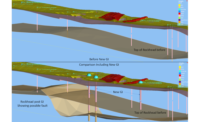The tablet software system also makes Kleinfelder reports easier and faster to search for particular data. RTD staffers, for example, can pull up in seconds reports cataloged by geographic work area and type of work such as walls, bridges and track.
"We anticipate using 100 to 500 records a day, depending on what's going on," says Bennett. "We estimate we would need something like 200 file cabinets to store comparable paper records."
RTD's Hinton says Eagle P3 will generate millions of documents, some of which must be stored for as long as 28 years—and they'll be mostly digital. "This needs to be the direction we go for bigger projects," he says.
The two-phase, $2.1-billion Eagle P3 commuter rail project now under construction involves building 36 miles of rail, 30 bridges and 15 rail stations. A two-square-block maintenance facility also will be built off 48th Avenue.
Phase 1, launched in mid-2010 with the selection of Denver Transit Partners as project builder and operator, includes property acquisition, construction of the East Corridor and maintenance facility, and the purchase of rail vehicles. Phase 2, started in mid-2011, consists of the Gold Line and a short segment of the Northwest Rail Corridor. The second phase began after RTD got a $1.03-billion grant from the Federal Transit Administration and ground was broken on the Gold Line.
RTD and DTP report Eagle P3’s recent progress as follows:
• A one-mile-long section of a Coors Field parking lot is under construction for the East Corridor, including moving utilities and installing retaining walls for rail that will come from nearby Union Station. That work must be finished by the Colorado Rockies 2012 opening day, April 9.
• Eight miles of fiber optic communication line for the East Corridor along the Union Pacific right-of-way have been moved to allow for commuter rail, and wet utility relocations are under way.
• Utility relocations along the Gold/Northwest alignment started in December.
• Building demolitions continue along all three lines, and RTD continues to acquire rights-of-way.
• The first 50 rail cars have been ordered from Hyundai-Rotem Co. and are being made in South Korea.
• Maintenance facility construction is expected to start later this year and be finished in 2014.
— Paula Moore







